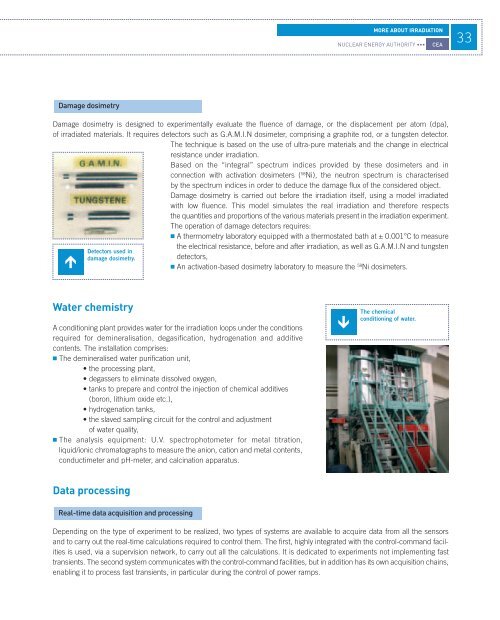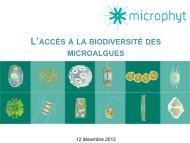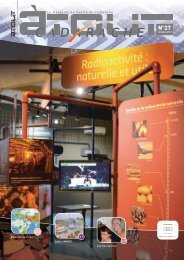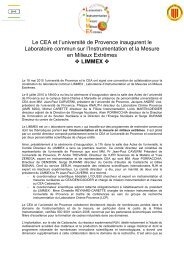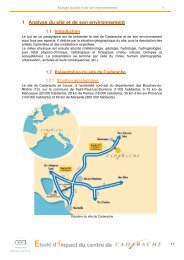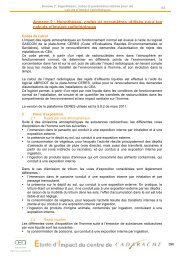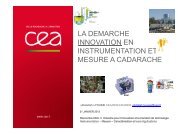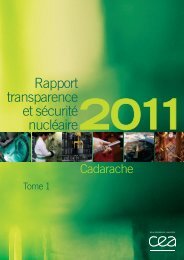OSIRIS REACTOR - Centre de Cadarache - CEA
OSIRIS REACTOR - Centre de Cadarache - CEA
OSIRIS REACTOR - Centre de Cadarache - CEA
- No tags were found...
Create successful ePaper yourself
Turn your PDF publications into a flip-book with our unique Google optimized e-Paper software.
MORE ABOUT IRRADIATIONNUCLEAR ENERGY AUTHORITY ••• <strong>CEA</strong>33Damage dosimetryDamage dosimetry is <strong>de</strong>signed to experimentally evaluate the fluence of damage, or the displacement per atom (dpa),of irradiated materials. It requires <strong>de</strong>tectors such as G.A.M.I.N dosimeter, comprising a graphite rod, or a tungsten <strong>de</strong>tector.The technique is based on the use of ultra-pure materials and the change in electricalresistance un<strong>de</strong>r irradiation.Based on the “integral” spectrum indices provi<strong>de</strong>d by these dosimeters and inconnection with activation dosimeters ( 58 Ni), the neutron spectrum is characterisedby the spectrum indices in or<strong>de</strong>r to <strong>de</strong>duce the damage flux of the consi<strong>de</strong>red object.Damage dosimetry is carried out before the irradiation itself, using a mo<strong>de</strong>l irradiatedwith low fluence. This mo<strong>de</strong>l simulates the real irradiation and therefore respectsthe quantities and proportions of the various materials present in the irradiation experiment.The operation of damage <strong>de</strong>tectors requires: A thermometry laboratory equipped with a thermostated bath at ± 0.001°C to measureDetectors used indamage dosimetry.the electrical resistance, before and after irradiation, as well as G.A.M.I.N and tungsten<strong>de</strong>tectors, An activation-based dosimetry laboratory to measure the 58 Ni dosimeters.Water chemistryA conditioning plant provi<strong>de</strong>s water for the irradiation loops un<strong>de</strong>r the conditionsrequired for <strong>de</strong>mineralisation, <strong>de</strong>gasification, hydrogenation and additivecontents. The installation comprises: The <strong>de</strong>mineralised water purification unit,• the processing plant,• <strong>de</strong>gassers to eliminate dissolved oxygen,• tanks to prepare and control the injection of chemical additives(boron, lithium oxi<strong>de</strong> etc.),• hydrogenation tanks,• the slaved sampling circuit for the control and adjustmentof water quality, The analysis equipment: U.V. spectrophotometer for metal titration,liquid/ionic chromatographs to measure the anion, cation and metal contents,conductimeter and pH-meter, and calcination apparatus.The chemicalconditioning of water.Data processingReal-time data acquisition and processingDepending on the type of experiment to be realized, two types of systems are available to acquire data from all the sensorsand to carry out the real-time calculations required to control them. The first, highly integrated with the control-command facilitiesis used, via a supervision network, to carry out all the calculations. It is <strong>de</strong>dicated to experiments not implementing fasttransients. The second system communicates with the control-command facilities, but in addition has its own acquisition chains,enabling it to process fast transients, in particular during the control of power ramps.


